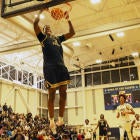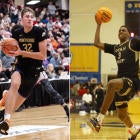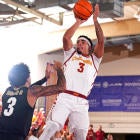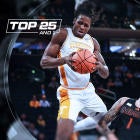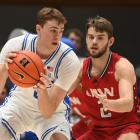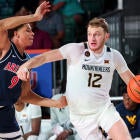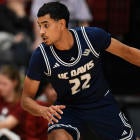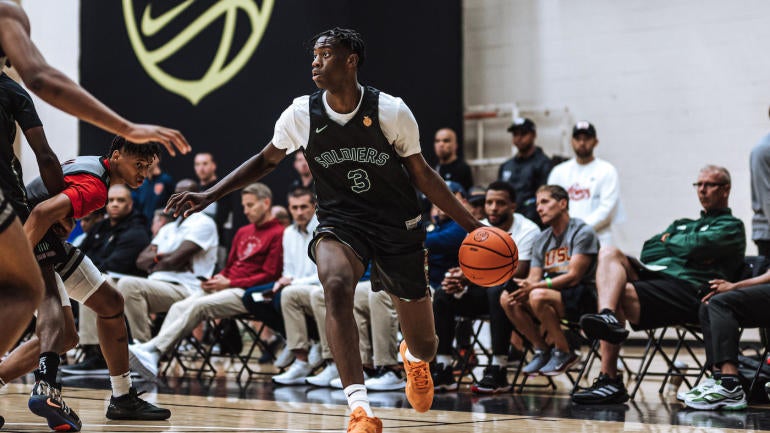
NORTH AUGUSTA, S.C. -- I remember coming to this gym the past two years and realizing that this rumored-about kid from middle-of-nowhere Maine was not only the real deal on the court, but had the potential to become one of the cooler stories we've seen in basketball in the past 20 years.
Cooper Flagg, of course.
And if you've been following basketball in general over the past few weeks, you realize that Flagg's time has officially come, months before he plays a game for Duke. While chatting in chilly gyms in recent days at the Nike Peach Jam, I remembered how much of Flagg's origin story came from the courts here at the Riverview Park Activities Center, where Nike's held its annual championship basketball event for close to 30 years. Before Flagg became the latest Next Big Thing, he was a rising fascination in high school circles.
He's since morphed from fascination to sensation.
Who knows what awaits him in the next nine months at Duke. Nevertheless, college basketball has a bona fide star regardless of not yet having played a Division I game. The build-up for that media sensationalism (some of it clickbait, but a lot of justified due to Flagg's obvious ability and potential) begins at this level, at these events. He'll be a freshman that matters in a way nobody has since another Dukie: Zion Williamson. The best freshman in the country last season was Reed Sheppard, who was no doubt adored by Kentucky fans and a well-known talent ... but he also only started five games because of John Calipari's stubbornness. Even as the national freshman of the year, Sheppard was somehow a Kentucky one-and-doner/top-three NBA pick who nonetheless couldn't break through to widespread national appeal.
Flagg will.
So, why am I bringing up Flagg in a July recruiting column when he's no longer in high school? Because I just spent five days on the road talking to dozens of college coaches and NBA scouts, and here's the most exciting part: For as awesome as Flagg could/should be, there's a chance he won't even be the best freshman in college basketball over the next two seasons. By the end of the 2026-27 season, he might not even be the second or third-best.
That's a great thing for the sport. The future is bright (particularly since G League Ignite is no longer around to lure away a handful of top-rated prospects annually).
College basketball doesn't need freshman stars in order to bring in big viewership, but boy do they help. And sports fans love something fresh and new. (I point you to none other than Paul Skenes in MLB.) Men's college basketball -- in a double-edged sword kind of way -- is unique in how it's boosted off star players who arrive with a blast and leave after just one year. No other sport is afflicted with this bittersweet arrangement.
But at least they're getting them, and folks, after spending some time on the road to see the next wave of players set to enter college basketball in 2025 and 2026, it sure seems like the next few years could be something special.
The biggest name of them all is the highest-rated player in high school, a rising senior named A.J. Dybantsa. The 6-foot-9 shooting guard/power wing is from Massachusetts, plays for the Oakland Soldiers on the Nike circuit and would appear to be one of the most gifted scorers to emerge from the prep ranks in the past 10-plus years.
Flagg was regarded as one of the best prospects to come out of high school in a generation.
Dybantsa might be better.
That's not merely my projection. I spent five days in Rock Hill, South Carolina, and North Augusta and took in Adidas' 3SSB (Three-Stripe Select Basketball) championship event in addition to the Peach Jam. I informally polled about two dozen coaches and scouts at the Adidas and Nike events about which prospect they liked best: Flagg, Dybantsa or another irresistible talent, 2026 blue-chipper Tyran Stokes (all three being No. 1 in their respective classes). Dybantsa received more votes than Flagg and Stokes combined.
Dybantsa and Stokes are playing together this week at Peach Jam with the Oakland Soldiers, providing a team-up so dominant, a championship run would land as no surprise. Here's an early glimpse of what they've done in North Augusta.
AJ Dybantsa and Tyran Stokes combine for 46 in a 23-point win to open up Peach Jam🔥
— B/R Hoops (@brhoops) July 13, 2024
Stokes: 25 PTS | 11 REB | 5 AST
Dybantsa: 21 PTS | 10-18 FG pic.twitter.com/jK4cBQsEAV
Dybantsa's scoring ability is outrageous. It's natural to wince at big statements made about teenagers, but here's the reality of what I heard at Peach Jam over the weekend from multiple evaluators: Dybantsa's offensive impact on the court at this level at this stage of his budding basketball career is akin to basically any of the best prospects to come through the ranks over the past 20 years. He's that good. He communicates with his teammates on basically every possession, has go-go-gadget limbs, loves the mid-range just as much as the 3 (and is efficient at both), and seems to have the ability to teleport from one spot to another in a flash.
"I'm just a loud person," Dybantsa told me.
If there's one adjective to describe Dybantsa's game, loud feels as fitting a descriptor as any.
He has a preternatural ability to affect every play. His presence is ever-present. He looks bigger/rangier than any 6-9 high school player I've seen. If he keeps on this path, he'll be the No. 1 pick in the 2026 draft. NBA scouts I talked to framed his potential, in a best-case scenario, as being a guy who will one day lead the NBA in scoring.
We're still 16 months away from Dybantsa playing in a college uniform, but yes, in case you were even a little skeptical, he will be a college basketball player.
"He is definitely going to college," his father, Ace, told me.
So we've got that coming in college basketball in 2025-26, which is electrifying. As for where we'll see Dybantsa play next year, he said a trimmed list of "five to seven schools" will be publicized by the end of the month. As of now, the list of hopeful schools is more than a dozen long, including almost all the blue blood names you'd expect to be in there, in addition to the likes of Alabama, Auburn and BYU.
Dybantsa told me this process has "been tough" as he's adjusted to being a high-profile high school athlete, but the insulation in his recruitment provided by his parents has made a lot of his day-to-day much more manageable. He'll be tracked by scouts, fans and coaches, essentially daily, from now until the night he's picked in the draft. The hype has already begun, but it will most definitely increase between now and his college debut in November of 2025.
The excitement about the future of basketball is not just with Dybantsa. The top of the 2025 class has immense potential -- and could have more impact in college hoops than any freshman group in five-plus years by the time they enroll. That's a big takeaway from a lot of people this July. In recent years, juniors and seniors have run the sport, harkening back to the way it was in the 1960s, 70s, 80s, 90s and into the 2000s.
Will that change a bit in 2024, 2025 and 2026? Remember, this upcoming season is the last in college basketball with the bonus COVID year for all players. Come 2025-26, we'll be back to normal, and the average age in the sport will downswing.
It could lead to multiple freshmen being impactful at an All-American level.
This class -- led by Dybantsa (wing) -- is also highlighted by Cameron Boozer (power forward) and Darryn Peterson (combo guard). At the top, some scouts think it could be an epic group for both college basketball and the NBA Draft. Toss in stud point guard Darius Acuff Jr. and big man Koa Peat to round out the top five in 2025, and you know what it feels like? A freshman class at the top end that could be as impactful as some of the late 2000s and 2010 years, when we had first-year players capable of not only being really good, but mattering on a national level and competing for national player of the year.
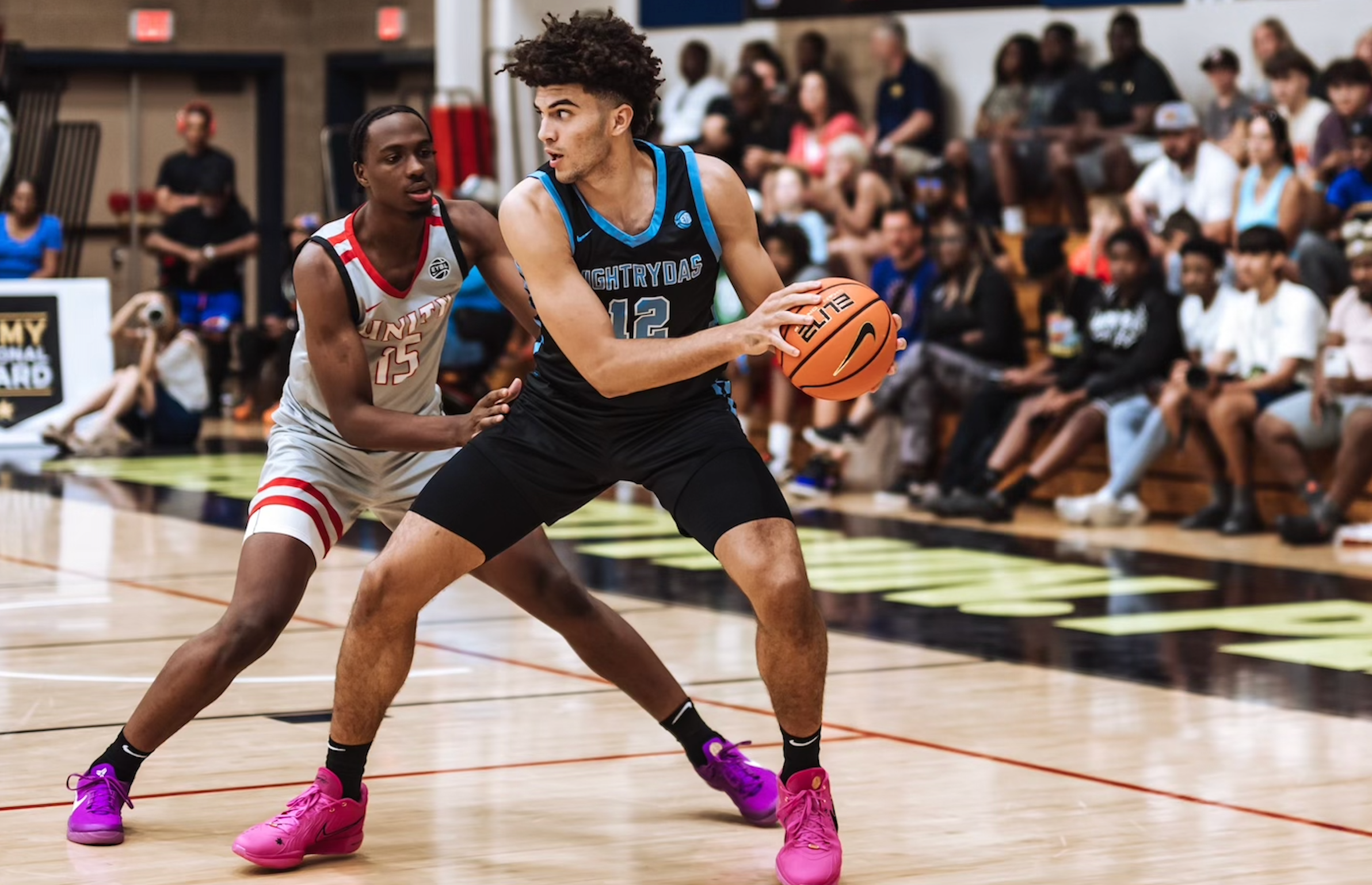
Freshmen have become less valued in the hyper-transfer portal era, and for the most part I think their impact stands to be more muted than we saw from 2006-2019. The top of the 2025 class seems different.
Boozer and his brother, Cayden, have been dominant players for their entire run in high school, be it on the summer circuit or in prep play. For all the Dybantsa hype, Boozer's considered by some to be a surer thing in college, where his role, knack for winning and reliability for playing his best against the best competition is considered tantalizing. Duke, Florida and Miami are considered the three schools with realistic chances to land the Boozer twins.
Cameron Boozer's productivity and translatable skills to the college level will have him entering the 2025-26 season with just as much intrigue as Dybantsa. Boozer had previously been linked with Flagg, due to being in the same class until Flagg reclassified, but we should see Boozer vs. Dybantsa at Peach Jam later this week, which would be among the more anticipated head-to-heads in the event's history.
As for Peterson, who plays on the Adidas circuit, he's not as big as the other two ... but he might be just as strong. He has an NBA-ready body right now. Peterson cuts an impressive figure and has traits as a combo guard that make him almost impossible to guard at this level. Some think Peterson should be on the same tier as Boozer and Dybantsa, and after seeing him dominate in Rock Hill, I can't disagree. If he's really the third-best player in this class, then college basketball's freshman crop a year from now will probably be better than the terrific group we're getting this year in Flagg, Rutgers' duo of Ace Bailey and Dylan Harper, plus Baylor stud V.J. Edgecomb.
As multiple coaches and NBA scouts told me: If Dybantsa, Boozer and Peterson were all eligible for the 2024 draft, they all may well have gone in the top five. Dybantsa almost certainly would have been No. 1.
As I watched Boozer, Dybantsa, Peterson, Peat and others, I remembered how there is no shortage of cautionary tales when it comes to overhyping prospects. Let's keep that at front of mind, too. Not ALL of these guys are going to continue to grow, get better and turn into All-NBA players or top-10 college guys. But there is an accepted truth among pretty much everyone in basketball that the 2025 class is better than many we've seen in recent years.
What do we have to thank for that? More than anything: NIL. With G League Ignite gone and Overtime Elite now allowed to bring in players but still have them be eligible to play in college, college basketball is benefiting from star talent in a way that it hasn't in some time. From a star power perspective, it's entering into another really good era.
So if you thought Flagg's inbound season at Duke would be a one-year burst for college basketball, think again. He should be tremendous. But there's a good chance we see even better players. The future of college basketball for the next three years looks bright -- and poised to deliver on freshman star power in a way we haven't seen since Zion. That's a huge victory for American basketball across the board.









